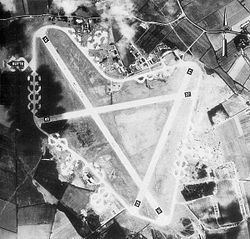Airport type Military In use 1944-1945 (1945) 00/00 0 Owner Air Ministry | Elevation AMSL 39 ft / 12 m Year built 1943 | |
 | ||
Operator | ||
Royal Air Force Station Boreham or more simply RAF Boreham is a former Royal Air Force station in Essex, England. The airfield is located approximately 4 miles (6.4 km) north-northeast of Chelmsford; about 30 miles (48 km) northeast of London
Contents
- USAAF use
- 394th Bombardment Group
- 315th Troop Carrier Group
- RAF use
- Postwar Governmental use
- Current use
- References
Opened in 1944, it was used by the United States Army Air Forces. During the war it was used primarily as bomber and a troop transport airfield for paratroopers. After the war it was closed in late 1945.
Today the remains of the airfield are partially used as a gravel quarry as well as the Essex Police Helicopter Unit.
USAAF use
Boreham was known as USAAF Station AAF-161 for security reasons by the USAAF during the war, and by which it was referred to instead of location. It's USAAF Station Code was "JM".
394th Bombardment Group
The first use of Boreham airfield was by the 394th Bombardment Group, arriving from Kellogg AAF, near Battle Creek, Michigan on 10 March 1944. Operational squadrons of the group were:
Their group marking was a white diagonal band across the fin and rudder.
In the weeks that followed, the 394th was repeatedly sent to attack bridges in occupied France and the Low Countries, which led to its dubbing itself 'The Bridge Busters'. The 394th was moved on 24 July to RAF Holmsley South in the New Forest.
315th Troop Carrier Group
Boreham then passed to the 315th Troop Carrier Group in March 1945, which flew 80 Douglas C-47 Skytrains to drop men of the British 6th Airborne Division during Operation Varsity, the assault on the Rhine River.
RAF use
The following units were here at some point:
Postwar Governmental use
The airfield was closed in 1945. The Essex County Council made use of some of the domestic site Nissen huts to house the homeless and the land was used by Co-Partnership Farms.
Current use
With the facility released from military control, in 1946, the West Essex Car Club developed the 4.76 kilometre perimeter track for motor racing. Although not on the official Grand Prix calendar, Boreham Circuit hosted competitive races between 1949 and 1952. Among the teams that raced at Boreham were BRM, Connaught, Frazer Nash and Talbot-Lago. Among the drivers who raced there were Mike Hawthorn, Stirling Moss and Ken Wharton. In 1955 the Ford Motor Company bought the airfield to use as a test facility for trucks, as well as the base for their Competitions Department where they prepared their cars.
In the late 1970s Boreham Proving Ground was the test site for Ford Heavy Truck Development. The development engineers at nearby Ford Dunton worked out various test programmes, and the Test Engineers at Boreham carried these out and reported back the data. One common test was RLD, or 'Road Load Data', where a chassis would be fitted with various strain gauges, and the data from these recorded. This was the main test site for Ford Trucks, and the Ford Cargo, released in 1980, was extensively tested here against competitor trucks. There were many various surfaces at Boreham to drive the trucks on. "Rest of the World" road, was a fairly rigorous route, with smooth surfaces, some undulating surfaces and some pot-holes. "Korean Road" was full of pot-holes and considered to be the worst test for a truck. Test drivers were not very happy if they were allocated four days of driving "Korean Road" to gather RLD since they were bumped around in the cab constantly. Aside the main entrance to Boreham was a small unit that was Ford Rally Sport. They built the Ford rally cars of the late 70s and early 80s there.
In July 1990, the Essex Police Air Support Unit began operating their Aérospatiale Twin Squirrel from the airfield, and in 1992 a hangar to house this helicopter was constructed beside the control tower. The runways and 40 loop hardstands still remained and the south-west hangar was in use as a store.
During the 1990s the airfield began to be dismantled for aggregate. Pioneer Aggregates has an interest in the southwest part of the airfield and much of the airfield has been subjected to extensive gravel extraction.
The north side of the airfield remains relatively intact with the exception of the dispersal loop hardstands, which have been removed. The control tower remains, which is used by the Essex Police Helicopter Unit with their Eurocopter EC-135T a T2 hangar and short concreted lengths of runway ends. The remaining parts of the former runways, perimeter track and hardstands are now grassy areas.
